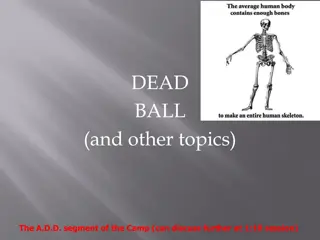Understanding Rule 4: Ball In Play, Dead Ball, Out of Bounds
Exploring Rule 4 of the game rules, this article delves into Ball In Play, Dead Ball, and Out of Bounds situations, discussing key scenarios like legal snaps, live ball becoming dead, and the impact of inadvertent whistles. It covers rules regarding ball positioning, player actions, and referee signals, providing a comprehensive guide to handling different game situations effectively.
Download Presentation

Please find below an Image/Link to download the presentation.
The content on the website is provided AS IS for your information and personal use only. It may not be sold, licensed, or shared on other websites without obtaining consent from the author. Download presentation by click this link. If you encounter any issues during the download, it is possible that the publisher has removed the file from their server.
E N D
Presentation Transcript
Rule 4 Ball In Play, Dead Ball, Out of Bounds Chet Jackson
Rule 4: Section 1. Ball in Play - Dead Ball Dead Ball Becomes Alive Article 1. After a dead ball is ready for play, it becomes a live ball when it is legally snapped or legally free-kicked. A ball snapped or free kicked before it is ready for play remains dead. No Illegal Place Kicks-Can t uses devices that elevates the ball for kicking purposes. Ball s lowest point no more than one inch above the ground. (5Yds Succeeding Spot). No Snapping ball or Kicking off before ready for play (Ball remains Dead, should have several whistles to prevent fouls/injuries)
Rule 4: Section 1. Ball in Play - Dead Ball Dead Ball Becomes Alive Article 1. After a dead ball is ready for play, it becomes a live ball when it is legally snapped or legally free-kicked. A ball snapped or free kicked before it is ready for play remains dead. Snapper cannot lift or move ball forward (Talk to the center the first time) During legal snap, B cannot bat the ball before A completes the snap (Team B Foul-Dead ball-5yds succeeding spot, Team A ball).
Rule 4: Section 1. Ball in Play - Dead Ball Live Ball Becomes Dead Article 2. a. A live ball becomes a dead ball as provided in the rules or when an official sounds his whistle (even though inadvertently) or otherwise signals the ball dead. b. If we have an inadvertent whistle
Rule 4: Section 1. Ball in Play - Dead Ball b. If we have an inadvertent whistle (Own it! Slow Whistles) 1.Ball in player possession may keep ball and elect to put the ball in play where declared dead or repeat the down 2.Loose ball (fumble backwards or illegal pass), team in last possession may put the ball in play where possession was lost or repeat the down 3.During a legal forward pass or a free or scrimmage kick, then the ball is returned to the previous spot and the down is repeated 4.If after team B gains possession on the try or during an extra period, then the try is over or extra-period possession series is ended.
Rule 4: Section 1. Ball in Play - Dead Ball b. If we have an inadvertent whistle (Own it! Slow Whistles) I. 2nd and 7 from the B35, Team A breaks a run up the middle and down the sideline. As the runner crosses the B5, the Back Judge signals touchdown and blows his whistle. A. The referee should yell at the Back Judge for making the dumb mistake so that he realizes that he should never do that again B. Team B can take the option of replaying the down since the Back Judge was there to bail them out C. Team A can elect to put the ball in play 1st and Goal at the 5
Rule 4: Section 1. Ball in Play - Dead Ball b. If we have an inadvertent whistle (Own it! Slow Whistles) I. 4th and 16 at the 50-yard line. At the snap, B1 is offside. Team A advances the ball to the 30-yard line and fumbles. During the loose ball, an inadvertent whistle is sounded. A. Team A must accept penalty and replay 4th Down, 4th and 11 B. It s a kick, we must replay 4th Down C. Team A may refuse the penalty and may elect to put the ball in play on the 30-yard line, 1st and 10 c. Fouls that occur during any of the above will be administered as in any other
Rule 4: Section 1. Ball in Play - Dead Ball Ball Declared Dead Article 3. A live ball becomes dead and an official shall sound his whistle or declare it dead: 17 different ways as described in a - q in 4-1-3 Of note: Forward Progress of ball carrier; ball carrier is tackled or falls and any part of his body (except hand or foot) touches ground; ground causes runner to lose ball, 4th down fumble rule, simultaneous catch or recovery of loose ball; runners helmet comes off; airborne player is held or carried & prevented from immediate return to ground
Rule 4: Section 1. Ball in Play - Dead Ball Ball Declared Dead Article 4. No player shall put the ball in play before it is ready for play (Dead-ball-foul; 5-yds from the succeeding spot) Article 5. Play clock is 25 seconds (Be smart, good R & BJ communication)
Rule 4: Section 2. Out of Bounds Player Out of Bounds Player or airborne player that touches anything, other than another player or game official, on or outside a boundary line Player who touches a pylon is out of bounds Held Ball Out of Bounds Ball is out of bounds when either ball or ball carrier touches ground or anything else that is out of bounds, or or that is on or outside a boundary line except another player or game official
Rule 4: Section 2. Out of Bounds Loose Ball Out of Bounds A ball not in player possession, other than a kick that scores a field goal, is out of bounds when it touches the ground, a player, a game official or anything else out of bounds, or that is on or outside a boundary line a.Ball touching a pylon is out of bounds behind the goal line (touchback/safety) b.A live, loose ball that crosses a boundary line and then is declared out of bounds is out of bounds at the crossing point
Rule 4: Section 2. Out of Bounds Out of Bounds at Forward Point A live ball is declared out of bounds at it s most forward point even if it does not cross a boundary line. A.R. 4-2-4-1 - Player with one foot out of bounds behind the goal line touches loose ball in the field of play. Ball would be dead at most forward point in field. Exception - Untouched free kick that goes out of bounds is a foul on team A
Rule 4: Section 2. Out of Bounds Out of Bounds at Forward Point Ball breaks plane of goal line prior to or simultaneous to the runner going out of bounds is a Touchdown Reciever in opponent s end zone that is in contact with the ground reaches over the sideline or endline is credited with a Completed Pass Runner dives or jumps and is airborne when crossing the sideline with possession of the ball gets progress to the Forward Point where the ball goes out of bounds.
Rule 4: Section 2. Out of Bounds - A42 returns a kickoff and sprints down the sideline. While running out of bounds the line judge makes contact with A42 at the B20. A42 continues to the end zone. Ruling: Touchdown, the ball carrier is NOT out of bounds (Remember that it is other than another player or game official - A player with one foot out of bounds behind a goal line touches a loose ball in the field of play. Ruling: Ball is out of bounds and dead at its most forward point in the field of play. If this loose ball was an untouched free kick, it is a free kick out of bounds and a foul. (3 Options)























